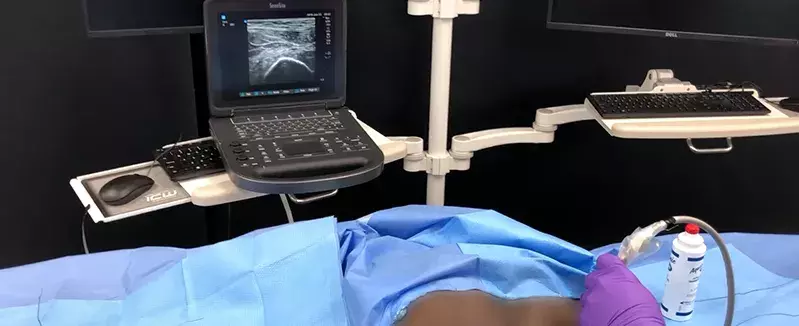
“Cadaveric study investigating the femoral nerve-sparing volume for pericapsular nerve group (PENG) block” https://rapm.bmj.com/content/48/11/549
Optimal Anesthetic Volume for PENG Blocks
What is the ideal volume of local anesthetic for a PENG block to ensure it remains motor-sparing? Opinions vary, with some sources recommending 20 milliliters and others suggesting 10-15 milliliters. The article referenced above delves into an investigation of dye dispersion in cadavers to determine the optimal anesthetic volume for the PENG block that preserves its sensory-exclusive benefit.
Evaluating the Effective Anesthetic Volume for the PENG Block in Cadaver Studies
First described in 2018, the PENG (Pericapsular Nerve Group) block has emerged as a motor-sparing technique primarily focusing on the sensory branches of the femoral, obturator, and accessory obturator nerves. Despite its initial promise, subsequent observations revealed that a notable fraction of patients—45% at 3 hours and 25% at 6 hours post-procedure—reported experiencing a degree of quadriceps muscle weakness. Prompted by these findings, a specialized cadaver study was conducted to ascertain the optimal dye volume that would effectively target the area between the anterior inferior iliac spine (AIIS) and the iliopubic eminence (IPE) whilst preserving femoral nerve function. This exploration, detailed by Leurcharusmee et al. in 2023, illuminated two primary mechanisms by which the local anesthetic might inadvertently influence the femoral nerve: one, through the inaccurate placement of the needle within the psoas muscle leading to ventral migration of local anesthetic towards the femoral nerve, and two, the diffusion of a high volume of anesthetic along the medial border of the iliopsoas muscle or through the intermuscular space between the pectineus and psoas muscles. After rigorous examination over a year involving 32 different cadavers, the research revealed that an anesthetic volume of 13.2 milliliters strikes the ideal balance for executing a PENG block that spares the femoral nerve in 90% of scenarios. Notably, the study found the primary avenue for local anesthetic to reach the femoral nerve was retrograde migration through the psoas muscle.
Optimizing Needle Placement and Volume for Effective PENG Blocks
To capitalize on the benefits of the PENG (Pericapsular Nerve Group) block, it is crucial to maintain precise needle placement between the iliac bone and beneath the psoas muscle while also utilizing the right volume of anesthetic. These techniques are not only pivotal in aiding patient recovery by ensuring optimal motor function but also in satisfying the surgical team’s expectations for post-operative outcomes. Emphasizing these best practices, the PENG block is also an integral part of Maverick Medical Education’s Regional Anesthesia Essentials Techniques course, providing comprehensive training for healthcare providers. As we continue to advance in regional anesthesia, let’s keep our focus sharp: Block on, Mavericks!
About the Author
Greg Gill is currently a Staff CRNA at NorthStar Anesthesia at UT Health – Tyler, TX and in the United States Army Reserve Nurse Corps. Originally working through Tyler Junior College to University of Texas at Tyler and on to Texas Wesleyan University, Greg was exposed to the benefits of Regional Anesthesia through Maverick Medical Education and became passionate about ultrasound-guided regional anesthesia.

